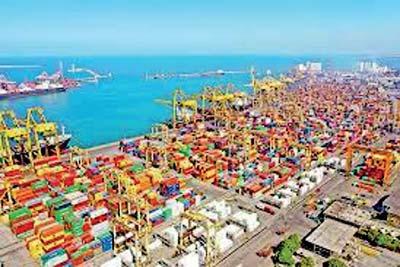Reply To:
Name - Reply Comment
 Sri Lanka’s Gross Domestic Product (GDP) is estimated to have contracted 11.5 percent in the first quarter of 2023 from a year ago amid high interest rates, increased input prices, import restrictions and lower earnings from apparel exports, the Department of Census and Statistics (DCS)
Sri Lanka’s Gross Domestic Product (GDP) is estimated to have contracted 11.5 percent in the first quarter of 2023 from a year ago amid high interest rates, increased input prices, import restrictions and lower earnings from apparel exports, the Department of Census and Statistics (DCS)
said yesterday.
During the quarter under review, agricultural activities expanded by 0.8 percent from 4.4 percent contraction a year ago, while industry and services declined by 23.4 percent and 5 percent respectively against negative growths of 3.7 percent and 1.8 percent.
Agriculture contributed 8 percent, industry 28.7 percent and services 58.2 percent to the GDP at current prices while taxes less subsidies on products component contributed
5.1 percent.
“When compared to the first quarter of year 2022, the unfavourable condition that prevailed in agricultural activities has been changed to a favourable situation by the first quarter of 2023 and has ensured some sort of relief in the agriculture sector,” DCS said in a
press release.
It also said the economic background of the country did not encourage investments during this period due to the high interest rates.
“Hence, most of public and private construction works were halted due to the increase of input prices in the construction sector while restrictions imposed on imports by the government have brought an adverse effect on the manufacturing industry sector and services sectors.
And also, the high input prices have caused the decline in production of manufacturing and some of agricultural activities. In addition, the decline in the exports of the apparel sector was experienced during this quarter,” DCS noted.
The expansion in agricultural activities were mainly driven by ‘Growing of rice’ (42.1 percent) as Sri Lankan farmers began receiving the required fertilisers and agrochemicals following a ban on such items.
The decline in industrial activities was mainly a result of the weakened construction sector activities. During the quarter under review ‘Construction’ recorded a negative growth of 38.3 percent.
The ‘Manufacture of coke and refined petroleum products’ is the only activity with a positive growth rate in this quarter under industrial activities, indicating an expansion of 92.9 percent.
Affecting the services activities were the ‘Insurance services’ and ‘Financial service activities’ which reported declines of 38.3 percent and 33.2 percent respectively.
The government expects economic growth to turn positive in the final quarter of this year.
Last week, the World Bank projected Sri Lanka’s economy to contract by 4.3 percent this year, before recording a 1.2 percent positive growth in the first quarter of 2024. The International Monetary Fund (IMF) expects Sri Lanka’s economy to shrink 3.1 percent this year.
Sri Lanka’s economy is estimated to have contracted 7.8 percent in 2022.